#which means NOBODY draws their CANON ESSENCE TOGETHER????????
Explore tagged Tumblr posts
Text

World’s only willeli shipper left
#im so desperate here yall#have to go on 2018 pixiv for anything at all#which means NOBODY draws their CANON ESSENCE TOGETHER????????#like avars chariot and avars follower was in 2023 why nobody give af#girl help me#my art#idv#identity v#idv forward#william ellis#idv seer#eli clark#willeli
20 notes
·
View notes
Text
Star Wars Episode VIII - The Last Jedi Review
Thanks to a certain streaming service I was finally able to watch Star Wars Episode VIII – The Last Jedi. And I guess I have an unpopular opinion on it. It seems no other Star Wars movie, not even The Phantom Menace, received such a major backlash. Nonetheless I am trying to be unbiased and as honest als possible. As always, spoiler alert.
Ready for light speed!

The film opens wih the First Order (basically the Empire) hunting down the remains of the Resistance (basically the Rebel Alliance) after the destruction of the Starkiller Base (basically a more powerful Death Star). The Resistance is having a hard time losing their enemy, because, as it turns out, they have a device which allows them to track down ships while they are in hyperspace.
Finn, the deserted stormtrooper meets Rose Tico and together with Poe Dameron they develop a plan to infiltrate the First Order' mothership Supremacy and deactivate the device. But they keep it secret, because they fear that Vice Admiral Holdo would never agree to it. Finn, Rose and BB-8 fly to a casino on Cantonica to get the best code cracker in the galaxy. They hire DJ instead, a dubious code cracker who helps them in exchange for Rose's amulet.
At the same time Rey is trying to convince Luke Skywalker, who lives in exile, to help the Resistance. He refuses, stating that he blames himself and the Jedi for the treason of Ben Solo a.k.a. Kylo Ren.
While at first every word she said was wrong, Rey learns the true nature of the force herself, cuts a stone in half with a lightsaber and even has a telepathic conversation with Kylo Ren. He then tells her that Luke had tried to kill him. Luke on the other hand tells Rey, that Kylo destroyed his Jedi academy and killed most of his students. Rey however believes there is still something good left in Kylo, so she hops on the Millennium Falcon and leaves Luke behind on his exile planet, hoping she can bring Kylo over to join the Resistence.
Luke then tries to burn all that is left from the Jedi scripts. Yoda's force ghost appears and he tells him in his iconic grammar that failure the greatest teacher is.
Meanwhile Finn, Rose and DJ managed to infiltrate the Supremacy. Rey arrives there in an escape pod and meets Kylo. He brings her to Snoke. It comes to a dramatic showdown, where Kylo kills Snoke and helps Rey to escape. He does however not switch sides.
Finn, Rose and BB-8, who were surrounded by Stormtroopers thanks to DJ's betrayal, also escape. Poe has raised a mutiny against Holdo to buy them some time. He puts her under arrest and goes to the bridge. But then Luke Skywalker or rather a mental manifestation of him, shows up.
The First Order's fleet is still after them, so they decide to abandon the Raddus. Holdo however stays behind onboard the Raddus and performs a kamikaze maneuver, flying the ship with lightspeed into to the Supremacy so it gets destroyed and the Resistance ships can escape to a base on planet Crait.
Here the First Order makes a last attempt to smash the Resistance but Luke's projection shows up to distract them. The Resistance escapes and Luke, who never physically left his exile, exhausted from his massive performance, dies in a similar way Yoda did in „Return of the Jedi“.
In a final scene, back on Cantonica, we see a bunch of children who are obviously force sensitive and telling each other stories about Luke Skywalker and the Rebel Alliance.
This may come as a shock to some of you, but I really liked it. I even would go so far as to say, and as blasphemous as it sounds, it captures the very essence of Star Wars. While „The Force Awakens“ felt more like a retelling of „A New Hope“, just with different characters, which was fine but not great, this film dares to be different and original. Sure it has some pacing problems. The sub plot with the resistence fleet trying to escape the first order and with Finn and Rose is a bit too long and too complicated, but it wasn't too bad. What I liked the most about it, was that we finally could see some conflict within the Resistence.
I'm glad they went back to explaining the force like Yoda did originally. As this mystical energy field that is generated by every living thing and that holds the galaxy together. No pseudo-scientific explanations here. Midi...what? Midichlorians? Never heard of those.
Star Wars has a tradition of drawing clear moral lines. There is good and bad, the Jedi and the Sith, the force and its dark side. My personal interpretation is that Luke's statement that the Jedi need to die is a reckoning with the black and white thinking of the past. Obi-Wan once said, that only a Sith deals in absolutes but on more than one occasion the Jedi did this as well, when they for example said that someone who was once tempted by the dark side, can not be redeemed, or when Yoda said „do or do not. There is no try.“ The truth Luke learned was, that the force itself is amoral, and that both the Jedi and the Sith can be arrogant and ruthless in their actions. He is convinced that as long as Jedi exist, there will be people who get tempted by the dark side.
For the first time, not only in the expanded universe, but actually in a movie, so as canon as it an get, the Jedi's ideology is scrutinised. Not only that. It is questioned by Luke Skywalker himself.
We also learn that Rey's parents were complete nobodies. Kylo Ren however is the son of Han and Leia. He is the heir of both Skywalker and Solo, and yet he was tempted by the dark side, or rather in a morally grey area. The message could not be clearer. Heritage means nothing.
At that one scene where Rose keeps Finn from sacrificing himself to destroy this weapon of the First Order, I at first could not decide if it's brilliant or stupid. Sometimes, and especially to win a war, sacrifices are nessecary, but if everyone sacrifices themselves in order to survive it kinda defeats the purpose, so I can't help but agreeing with her.
If I have anything negative to say about it, I'd say that it could have been at least 30 minutes shorter. The Finn and Rose scenes as well as the final showdown have a pretty problematic pacing.
And yeah it is a little irritating how good Rey is with literally everything, from lightsaber fighting to using the force. Things that normally take years, she manages within a short amount of time, depending on how convenient it is for the plot. Many people already called her a Mary Sue character and I can see why.
But maybe this is the point. Luke in his exile shares some similarities with the protagonist of Friedrich Nietzsche's „Thus spoke Zarathustra“. They both live as eremits and they both in a way speak about the death of God, which stands for the fall of an old belief system leaving us in a state of nihilism.
If you look at it that way, Rey could be a quite literal representation of the Übermensch, a being that actively overcomes nihilism and leads humanity to a new moral system that is beyond the categories of good and evil from the Jedi's perspective. She is not a superhuman because she is extremely powerful but rather because she realises a deeper truth, that the force can not guide her to what's right or wrong and that she has to figure this out for herself.
But if we consider what happens in the final scene in which the children draw hope from the old stories about the Jedi, this theory either falls completely apart or the movie totally misunderstood what Nietzsche was trying to say.
What the movie did surprisingly well was that it deviates from everything that came before where it needed to do that, while keeping true to its legacy. It may not be perfect, but I prefer this over the prequel trilogy anytime.
2 notes
·
View notes
Text
Why Do Certain Ships Become So Popular? (And Why Should Writers Rethink When They Do?) - Part 2
<- Start back at part 1 or you’re going to be very confused!
This time my victim of choice example is Klance (and Allurance and Lotura too).

In a previous post, I established the premise that shippers focus their efforts and attention on ships between characters who exhibit the most compelling dynamism, the greatest amount of emotional energy--good feelings or bad--that directly relates to one or more of the characters’ growth arcs... or the two characters whose emotional interactions most significantly affect a story’s main plot.
This idea (that shippers are looking for strong, dynamic emotional interactions that are directly tied to plot) feeds directly into my second premise: part of the popularity of slash ships comes from the fact that, very often, the strongest and most plot-relevant emotional events don’t occur between male characters and female characters, but between male protagonists and other male characters--due to a combination of 1) a much smaller number of female characters, 2) a majority of writers for anime/manga and American shows being male; 3) under-developed or poorly written female characters, and 4) the tendency to situate males in the hero, sidekick, and villain positions, increasing the chance that their actions will have greater importance in the story’s main plot.
In short, writers can unintentionally cause fans to prefer non-canon slash ships by writing more dynamic, better developed, and more plot-relevant interactions between their male leads than between the main character and his designated female love interest.
Now hang on. Before you get all up in arms, yes, I’m perfectly aware there are plenty of other reasons slash ships are popular, including:
A huge desire among LGBT+ fans for positive representation
The fact that m/m interactions appeal to straight women/others the same way w/w interactions are sexy to straight men/others
The tendency of shows, particularly from Japan, to deliberately queer-bait
The fact that many women vicariously ship male characters together because it allows them to imagine a relationship of “genuine equals,” particularly in areas where women feel they are still not treated equally to men
The tendency for “pair the spares” to result in m/m ships simply due to a lower number of available female characters
And so on
This isn’t written to negate any of those reasons or to imply that they aren’t major factors in the popularity of slash ships, not at all, but it has always, always struck me as reductive when I hear things like “Slash ships are only popular because girls think two dudes together is hot” (the fetish argument) or “Girls will ship any two good-looking male characters together regardless of canon. They just hate het ships” (the fetish argument with a side dish of misogyny).
In particular, this last one--an argument I’ve heard from a lot of male fandom members (but of course not all)--has always gotten under my skin, because it implies that girls who ship aren’t capable of critically analyzing the media we consume and identifying characters who have meaningful interactions and interesting potential. That we, unlike those viewers who adhere to the canon (typically heterosexual) relationships, are somehow reading these stories wrong, blind to “real” romance (namely the one between the male hero and his best girl/waifu), and/or misusing male characters with zero regard for their personalities--worse, this argument also implies that female fans deliberately hate or under-appreciate oh-so-perfectly written female characters whose romantic subplots are totally natural and not at all an unfortunate side effect of their position as the token chick on the team...
At its best, the statement: “Girls will ship any two good-looking male characters” is demeaning in its dismissal of a majority of slash shippers and their ability to read characters. At its worse, it’s this exact dismissal that continues to allow so many (primarily male) authors to write under-developed, unimportant, token female love interests: “It’s the girls [or the slash shippers] who are weird; there’s nothing wrong with the way we’re doing things.”
But guess what happens when well-written female characters whose actions are central to a story’s main plot are introduced and highlighted? Guess what happens when the emotional energy between a female lead and her male counterpart is the most compelling and dynamic in the series?
The (often canon) het ship suddenly--somehow--magically becomes well-liked by fans!
Zutara and Kataang vastly out-strip any slash Avatar pairings in popularity. Noragami’s Yatori commands a staggering following in the fandom. Is there anyone in their right mind who thinks Alucard/Integra wasn’t the best pairing to end Hellsing with? No one debates whether or not Ahiru and Fakir from Princess Tutu are true love. In Doctor Who, Rose and the Doctor reign so far supreme in the fandom that none of the other ships even need to exist though I actually prefer River. Terra and Aqua from Kingdom Hearts beat out every other Terra or Aqua ship by a mile (and this is in a series notorious for hating and under-shipping its female characters). Gekkan Shoujo Nozaki-Kun has no problem juggling three very well-accepted het ships--even while having a scene in which two male characters sit down and draw a gay manga together. Ain’t nobody suggesting Mr. Bates and Anna from Downton Abbey should be with anyone else, right? And this is just in the handful of shows I personally have time to watch. Anyone who reads or watches a series with well-written female characters can play this exact same game!
The obvious conclusion? Female fans are perfectly willing to ship heterosexual pairings--if they’re well-written.
It’s the same story all over again: when the real emotional energy, the dynamic core, the most plot-relevant interactions occur between a male and female character, they too can become the fan-preferred couple. (Shocking!)
Yes, yes, I hear you saying “B-But wait, sometimes the m/m ship is more popular even though the het love interest is well-written!” or “Sometimes girls ship guy characters who have never even met!” or “So what you’re saying is female fans wouldn’t ship slash if there were better het options available?”
1) Don’t get me wrong--there are certainly always exceptions. I’m pointing out a trend, not a rule. Sometimes a fandom has a separate, specific reason for elevating a non-canon slash ship above a well-written canon het ship. (Someone who is actually in the Fullmetal Alchemist fandom might be able to explain why Ed/Roy is more popular than Roy/Riza, probably?) And in situations where a slash ship and a het ship in a series both have equally strong emotional energy, my bet is that the slash ship will always come out on top because it gets the added benefit of people liking LGBT+ rep and straight girls (and anyone else) who just think m/m is hot.
2) Crack ships definitely do exist. But usually when a crack ship actually manages to become popular, it’s because fans have recognized the potential for a strong emotional energy between two characters. If the two characters could reasonably have strong tension because of similarities, differences, or other elements of their characters, then crack ships are still following the trend of aligning with emotional energy, even if that energy is only anticipated at the moment.
3) I definitely don’t mean to suggest that slash ships are shoddy seconds to fans who would “naturally” prefer het ships if good het ships were available. What I’m suggesting is only that it’s no surprise slash ships are so extremely and consistently popular across so many fandoms, because in terms of plot relevance, depth of writing, and meaningful interactions with each other, male characters so rarely have any real competition. A desire for LGBT+ representation and people living out power or equality fantasies through slash are certainly motivating factors and good and worthy reasons to write slash. But one unfortunate contributor to the popularity of slash ships is that male characters continue to occupy a place of privilege in modern narratives. Our heroes remain overwhelmingly male. Our sidekick/lancer/buddy characters remain overwhelmingly male. Our villain characters remain overwhelmingly male. That is to say: male characters continue to dominate all the most “plot relevant” roles in our narratives, and so long as male leads continue to be placed in roles where their most compelling emotional interactions and greatest sources of character growth are other male characters, slash ships will continue to dominate fandoms’ online presences.
(Hilarious: the dude bros who complain about the number of slash ships in their favorite series are often the very same ones supporting and becoming the writers whose shallow portrayals of female characters further bolster the popularity of said slash ships in the first place...)
Okay, I’ve made you wait long enough.
What does all of this have to do with Voltron?
Well, you’ve probably figured that part out already, actually.
If we consider the “emotional energy” and tension among Voltron’s main characters, there’s absolutely no question who is at the core, where the most plot relevant and meaningful emotional interactions have occurred, where the “heart” of the story is, in essence...

Hint: It’s Keith.
(Just a heads up: I’m going to use Klance as the example because it’s the most popular Voltron pairing according to the numbers, but any Sheith fan worth their salt could obviously very, very easily apply these ideas one-for-one to that ship, because clearly Shiro’s interactions with Keith are some of the most emotionally tense and compelling in the entire Voltron series--they are a consistent core of feeling energy for the show which naturally leads many people to support this ship. A large part of the reason that this post is tagged Sheith is because I am absolutely inviting Sheith shippers to use the theory and lens in this essay to analyze Sheith--using this idea to analyze Sheith will reveal a lot of intense emotional energy to discuss and validate that ship. I’m very tempted to put this paragraph in all caps or something so the Sheith shippers will actually read it and stop badgering me...)
Keith (and his relation with other characters) is the core of Voltron’s main plot, both in that he is positioned as the leader/the hero/the protagonist, and because, obviously, almost all of the series’ emotional high points (with the exception of “Crystal Venom” and Pidge’s search for Matt) somehow feature him.
Keith isn’t just central in the main plot though; he’s also central in the individual arcs of two other characters: Lance and Shiro. He’s a motivating and driving factor in both of these characters’ stories and change throughout the series, affecting their actions, attitudes, and self-worth, and so it should come as absolutely no surprise that Sheith and Klance are the series’ most popular ships.
But since Klance is the most popular pairing, the person I really want to talk about is Lance.
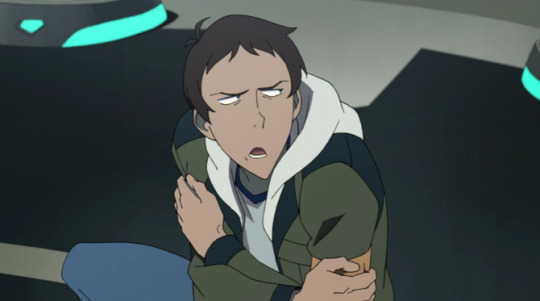
You can say a lot of things about Lance and the raging debates that occurred over whether or not Lance is a straight loverboy trope or not, but I don’t think any viewer of Voltron would deny that, if we consider the main cast members (Team Voltron plus Lotor), the core of Lance’s emotional energy and tension is Keith. His interactions with Keith--not even in a romantic sense, simply in a storytelling sense--are more important and dynamic than his on-screen interactions with any other main character.
From his laser focus on Keith at Garrison that caused him to invent a rivalry (this word is basically just a synonym for “emotional energy” at this point):
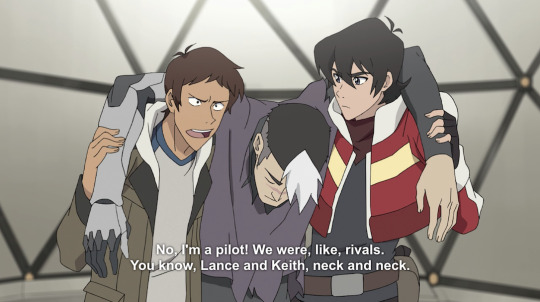
To comedic banter:

To the infamous bonding moment:
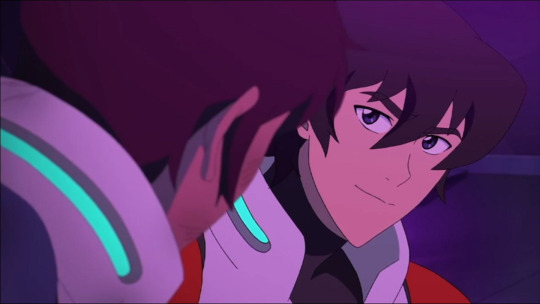
To a fledgling “right hand man” partnership:
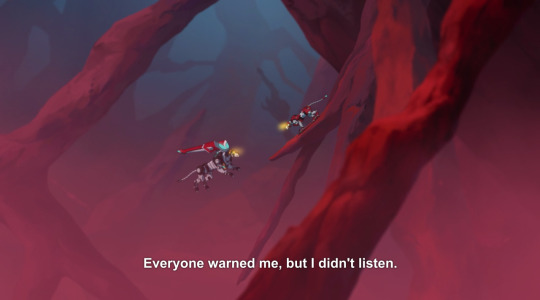
To Lance’s insecurities:

The story of Voltron itself continuously reiterates that Lance’s interactions with Keith are more dynamic, more intense (even if we’re talking about “Rawr, I hate you, we’re rivals!” emotions instead of lovey-dovey stuff), and more plot relevant than Lance’s interactions with other characters in the series. Lance’s emotional arc is irrevocably centered on Keith until very, very late in the series.
More importantly: Lance’s motivation and personal plot line as a whole are centered on Keith. At it’s most basic, Lance’s character arc seems like it was supposed to center on Lance’s sense of self-worth--despite acting confident, Lance was actually insecure about his ability to help save the universe. Theoretically, his narrative should have focused on him becoming confident about his place on the team and his value as both a friend and fellow paladin to the other main characters. His arc should have been (and I guess theoretically still is? It’s just not... ever given much attention?) about him overcoming his insecurity by learning to recognize his own unique talents and discovering the things that only he can do to help Team Voltron succeed. (Hell, the entire Allurance thing could have been framed as “She’s completely out of my league” ---> “Whoa, originally I was putting Allura on a pedestal but actually she’s as much a member of this team as me--we’re in this together, side-by-side.”)
Whether or not the semi-incoherent narrative of Voltron actually delivered on this promise is iffy, but the set up in season 1-3ish is all there and all Keith:
At Garrison, Lance viewed Keith as a road block in his quest to becoming a fighter class student. Keith’s achievements and talent became a measuring stick for Lance’s own capabilities. He imagined a rivalry to make himself feel better/less insecure. His drive not to lose out to Keith is what dragged Hunk and Pidge along to Shiro’s rescue and ultimately led to the discovery of the Blue Lion. Lance comparing himself unfavorably to Keith as a paladin and pilot contributed to (mostly) one-sided animosity throughout the early seasons that gave way to a scene of Lance attempting to step down from the team because he didn’t see himself worthy of the position in comparison to Keith:
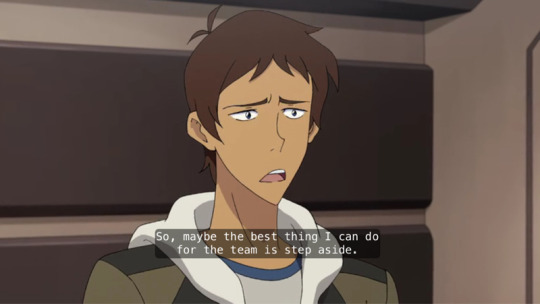
The logical conclusion that I think most fans would draw from these many scenes is that, as part of Lance’s overall character growth across the whole series, he needed to have a moment in which he recognized that he isn’t--and has never been--inferior to Keith.
Ultimately, the first five seasons continually reiterate the idea that, in terms of interactions, energy, and dynamic character growth, the most important main character in Lance’s story (other than Lance) is Keith.
Keith’s interactions with Lance are directly and immediately tied to Lance’s individual character arc/growth, and Keith is definitely the focus of Lance’s most meaningful emotional tension throughout seasons 1-5 at least.
Which means it shouldn’t come as any surprise that Klance is the most popular Lance ship, particularly when you set it side-by-side with the (increasingly canon) Allurance.

I just want to make this abundantly clear before I begin: I have absolutely nothing against Allurance shippers and, until it was done so poorly in season 5-6 (and potentially 7, I still haven’t even finished that one), I actually was okay with the possibility of Allurance being endgame because I thought there was potential for it to be done well. After what we’ve been given, I actually feel the Allurance shippers have been horribly shortchanged by the show’s real writing, and that I can’t personally support the ship the way it’s being written, but that’s not the fault of the characters themselves or anything inherently “wrong” with the ship. So please don’t take the rest of what I say here as ship hate--this is just observations from a literary analysis standpoint.
What has prevented Lance and Allura from gaining significant traction with the fans despite the fact that it’s edging close to canon territory if it isn’t canon already?
Well, one problem might be that Lance’s emotional energy has no bearing on Allura’s individual character development--and Allura’s emotional peaks have no bearing on Lance’s personal arc either (at least as far as it was established in early seasons and then left essentially unresolved).

Allura’s arc has, throughout the course of the show, centered on her ability to defeat her family’s foes, her grief for her lost people and planet, and her desire to follow in her father’s footsteps as a leader and in the Altean traditions as well. None of this has much of anything to do with Lance. Her growth as a character occurs--with the exception of the single shining scene on Naxela--completely independently of Lance. She lets her father’s memory go on her own in “Crystal Venom.” She faces Zarkon head-to-head by herself after rescuing Shiro. It’s Shiro who stops her from over-working herself to aid the coalition, not Lance. It’s Keith’s whose Galra blood forces her to re-examine and overcome some of her universal hatred for the Galra. It’s Lotor who helps her reach Oriande, and her own ingenuity that allows her to tame the White Lion and learn the secrets of Altean alchemy.
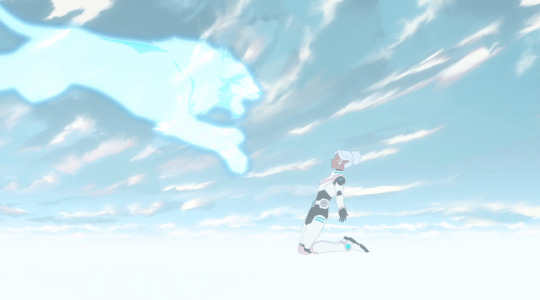
With the exception of the scene on Naxela where it was specifically Lance’s speech that motivated Allura to save the day, virtually all of her most charged emotions occurred elsewhere and with other characters, and there’s nothing in her personal goals--to be a strong leader, to revive her culture, to save the universe--that is intrinsically tied with Lance. He can encourage and aid her in those pursuits, but so can Shiro, Keith, Pidge, Hunk, and Coran. The role of fellow paladin and supporting ally isn’t unique to Lance. His interactions with her don’t fill a niche that drives her personal plot lines outside of the romance subplot.
And the same thing is true in reverse.

We get this nice scene of Allura encouraging Lance and helping him work on his insecurity... And then it is promptly never mentioned again. (Where did the sword go, guys? Where???) Lance gives up Blue to Allura and she’s almost immediately gifted at piloting the Blue Lion, while Lance is shown struggling with Red (once more in Keith’s shadow) and still hadn’t, as of the end of season 6, seemed to have mastered it to the same extent as Keith. It’s Keith, Laika (an alien dog--not Allura guys, an alien dog) and the SPACE MICE that Lance expresses his insecurities to, and it’s Coran who is there for Lance’s touching scene expressing his longing to return to Earth. Lance’s personal arc about growing into the paladin role and becoming a selfless person who puts the team before his own desire for glory once again occurs independently of Allura, with little to no interaction, and even fewer emotional high points between them, in the entire first half of the show.
For both of these characters, their “real emotional energy”--their tension both positive and negative--occurs with other characters. The “believability” and energy of this ship is diminished by the fact that it simply isn’t the most well-written of character pairs in the series. The romance subplot isn’t organically tied to either of their personal plot lines, and the depth of their one-on-one interactions pales in comparison to their, particularly Lance’s, interactions with other characters.
But huh... would you look at that... When a potential romantic interest came along whose interactions with Allura were both directly tied to her personal arc, her central character motivations, and her emotional high points...
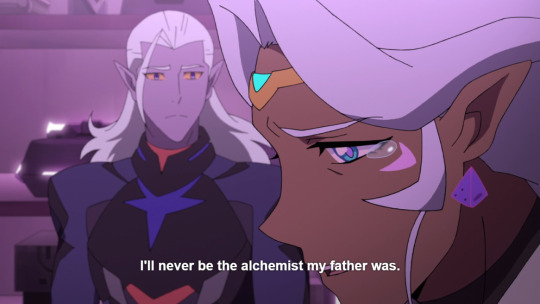
Isn’t it amazing how well it was received by the fandom--despite the fact that no one was really sure whether Lotor was evil or not? Now of course, I’m not going to ignore the fact that Lotura was probably helped along by leaving Keith, Lance, and Shiro free to ship elsewhere, but I don’t think the actual chemistry in the series’ writing itself should be ignored.
There was significantly, significantly more tension and nuance to Allura and Lotor’s interactions that any of Allura’s interactions with any of the other main cast, and their interactions operated not just in a romantic capacity, but also as a vehicle for Allura’s personal character growth:


The push and pull of these two characters and their scenes together sparked change in both of them, which augmented and increased the quality of their romantic arc while also furthering both of their own individual goals as characters.
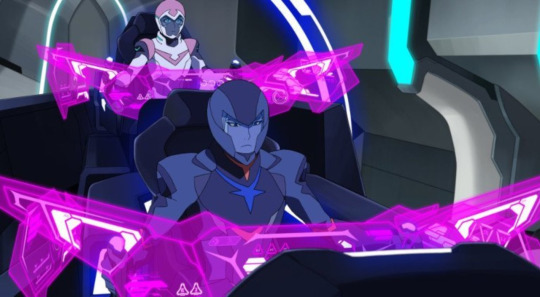
The story painted them as equals with mutual interests, a shared interest in Altean culture, both victims (at least initially) of their parents’ war, both distrusting but ultimately lonely people who were longing for connection to, in Allura’s case, what had been lost, and in Lotor’s case, what he theoretically had never been able to have (except the writers did him dirty so jk).
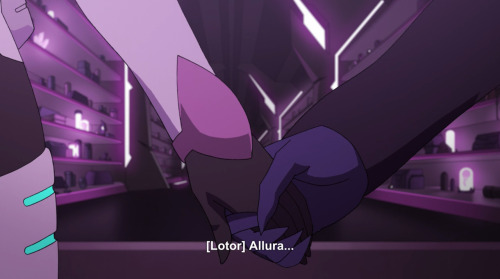
I just don’t think there are many people who would argue that Allurance--or Allura’s interactions with any other male character--have been written with near as much depth, engagement, and integration with her motivations as Lotor and Allura’s were. Their plot literally got more screen time one-on-one in a single seven episode season than Allura and Lance did in the 43+ other episodes...
And for the the short time that it lasted, this pairing was embraced by many fans. I might be biased because I immediately went out and followed every Lotura blog I could find, but to me it seems like it was well-liked and generally well-regarded among shippers until the colony reveal (and by many still after). I was very excited by the writing of this ship and definitely wanted something meaningful to come out of it. Part of the fandom’s immense outrage at Lotor’s reveal was, I think, linked to the fact that this ship had been so convincingly written into the series before it.
This, to me, is a perfect example of a situation in which the emotional exchange between two characters exceeds the strength and depth of their interactions with others, leading to immediate adoption and approval as a ship by the fandom. Where the real energy is, there are the shippers.
PHEW! Let me take a deep breath and come up for air. There’s a lot going on here, but boiling it down to the basic point I’m trying to make, and which I’ll address in a lot more depth in the third and final part of this: the way that a story is written profoundly affects what ships will or will not become popular with fans. Shipping isn’t an unpredictable beast that grows completely independently of its source material. The ways writers craft interactions between their characters--and the places where they invest the most and infuse the most life--are powerful tools that impact how fans view and come to love seeing characters both separately and in romantic relationships.
To that end, while there are numerous reasons slash ships are popular and continue to grow in popularity, one reason that should be considered seriously by all creative writers--fanfiction authors or aspiring original novelists--is the notion that shipping often aligns with the core of a story’s or character’s emotional energy, the pairs with the highest tension, the electric pulse of the story’s most meaningful moments. Non-canon ships of any sexuality swell to mega-popularity when fans perceive more depth and significance in the interactions of characters outside the canon pair, when the emotional work of the story is happening somewhere outside the intentional romantic plot line. Sometimes this is fine. But more often, this is a bad sign for creators--a sign that you’ve fumbled in the writing of your main romantic leads.
As writers, questions we rarely ask ourselves but often should are: “Where is the core of the tension in my story? Whose interactions are deepest and most central to the development of my main character?”
In other words: Where is the real emotional energy in my story?
In part 3 I’m going to provide one more excellent case-in-point, and then close out with a discussion of some take-aways for writers from all this that might help strengthen your romantic subplots, whatever your genre or whoever your characters.
Go on to Part 3 ->
#klance#sheith#allurance#lotura#voltron#voltron meta#voltron legendary defender#slash ships#het ships#writing advice#fanfiction writing advice#shipping#fandom meta#popular ships#writing romance#female characters#writing female characters#my poor ladies#all so mistreated#part two of the nerdiest essay ever written
990 notes
·
View notes